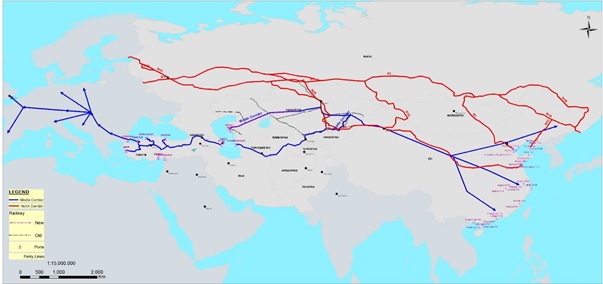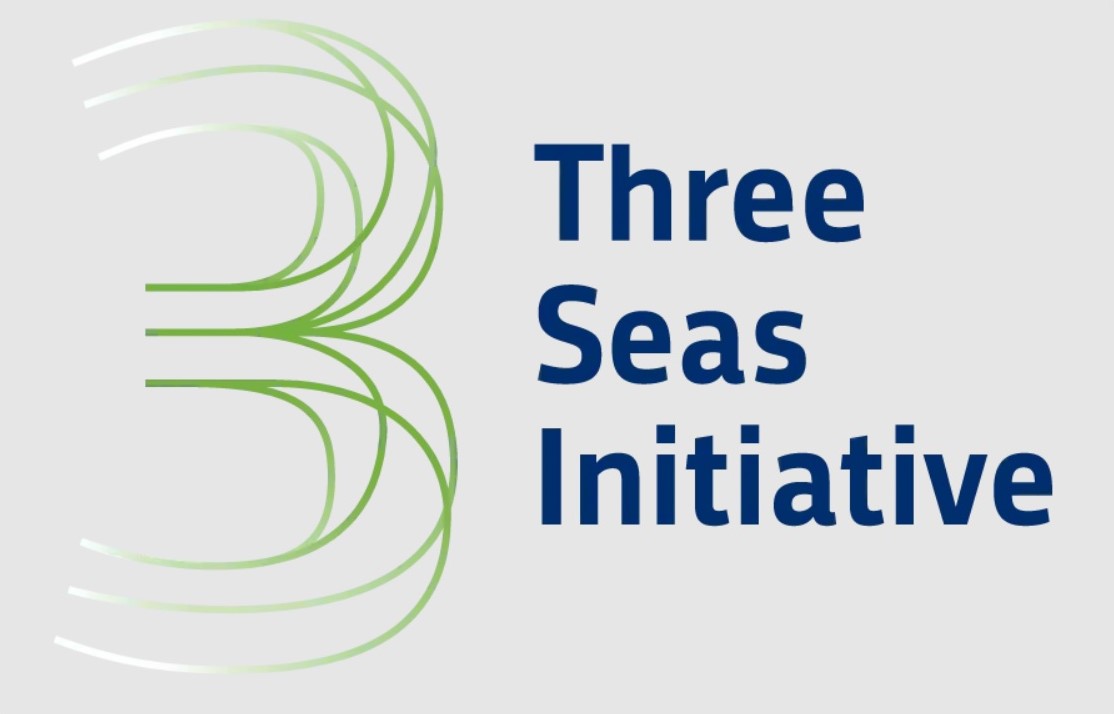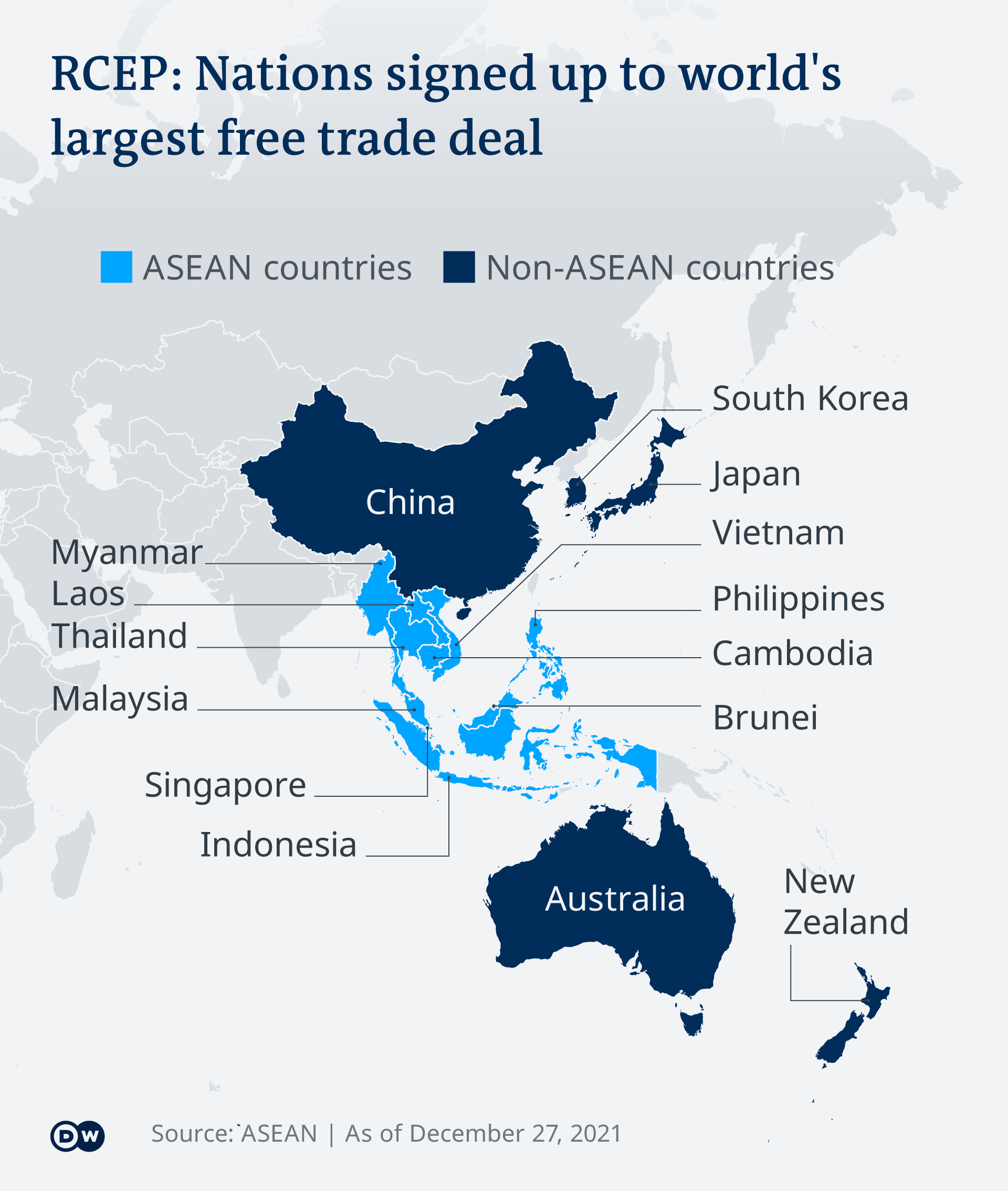
Deniz ÜNVER
Independent Researcher
With the ongoing war of Russia on Ukraine, the global supply chains have taken a hit. Previous to that, global supply chains had already been hit hard by the Covid-19 pandemic. The war has exacerbated the issues with major supply chains. For this reason, today, the system is in need of diversifying its trade and transport routes, as well as reshaping its logistics flow[1]. Particularly due to the war and the pandemic, the competitiveness of the Northern Corridor was diminished[2]. In contrast, the Middle Corridor, which is a multi-transportation route, has been under the limelight for a while. In fact, a positive trend was observed in the development of the Middle Corridor after the Russo-Ukranian war[3].
The Middle Corridor, or with its long name, the Trans Caspian East-West-Middle Corridor Initiative, starts from Turkey and passes through the Caucasus via Georgia, Azerbaijan, Central Asia, and ends in China[4]. In fact, the Middle Corridor passes through Georgia, Azerbaijan, and Caspian Transit corridor by rail and road[5]. Then, it reaches China via Turkmenistan-Uzbekistan-Kyrgyzstan or Kazakhstan route[6]. The route of the Middle Corridor attaches importance to the ports of Baku (Azerbaijan), Aktau (Kazakhstan), and Turkmenbashi (Turkmenistan), which are the main points for transportation on Caspian Transit Corridor[7].
The Middle Corridor is a crucial effort to reestablish the ancient Silk Road[8]. In this context, it integrates with China’s Belt and Road Initiative (BRI)[9].
The Middle Corridor promises benefits for many countries. It was designed to bring prosperity to the European Union, Central Asia, the Caucasus, and Türkiye, all of which are situated in the Chinese export route[10]. The Corridor offers opportunities for countries of Central Asia and South Caucasus to diversify their markets and recieved investments from European firms[11].
As a matter of fact, the Middle Corridor will bring several benefits to the landlocked Central Asian countries. Therefore, the Trans Caspian cooperation and infrastructure can be improved by this trade route with the establishment of free trade zones and logistical centers in Turkmenistan, Kazakhstan, and Azerbaijan[12]. In particular, it can be said that the establishment of the Middle Corridor will provide economic recovery to the Central Asian countries that have been hit hard by the pandemic. In addition to those advantages, the Middle Corridor will allow Central Asian countries to be less dependent on Russia in terms of infrastructure and logistics. It is known that the infrastructure of the Central Asian countries, despite all the developments since the end of the Cold War, are still mostly connected with Russia[13]. With the establishment of the Middle Corridor, the Central Asian countries can now acquire new roads and logistical ties.
Therefore, Ankara plays a crucial role due to its ties with the countries which are located in the route of the Middle Corridor[14]. Türkiye already has extensive business and trade ties with those countries[15]. In the Turkish view, Türkiye can increase its presence in Central Asian countries with the establishment of the Middle Corridor. This will happen through the increase of Turkish exports to Central Asia and increase in the import of raw materials from there[16]. Another significant benefit of the Middle Corridor to Türkiye is that it can improve the relations between Türkiye and the EU. There is no doubt that the EU- Türkiye relations have been strained for over a decade[17]. The partial improvement of relations can be accomplished by enhancing trade and business links via the Middle Corridor. Thus, it is beneficial for the EU since the countries which are located in the Middle Corridor route will be both exporters and importers for the EU in terms of natural gas and digitalization. Connecting Central Asia with the South Caucasus region can allow the EU to have a role in developing new markets[18].
Furthermore, the establishment of the Middle Corridor stands as an opportunity for the South Caucasus countries in terms of economic recovery and diversifying their business ties. In general, countries in the South Caucasus will have better trade relations with Europe due to increasing network of routes[19].
Apart from those, it has other advantages such as feasibility. When it is compared with the Northern Corridor, it can be seen that the Middle Corridor is a much more economical and faster trade route since it is 2000 km shorter, offers better climate conditions, and reduces the travel time by 15 days[20]. It is thus much more desirable to use the Middle Corridor instead of the Northern Corridor. Geographically, it is the shortest trade route between west of the China and the EU[21]. Thus, the Middle Corridor is beneficial for the cargo traffic in Asia, as it can reach the Middle East, North Africa, and Mediterranean region via ports in Türkiye[22]. Indeed, it is expected that the cargo transportation will increase six-fold to 3.2 million metric tons in 2022, compared to the previous year[23].
Finally, it can be concluded that the Middle Corridor is beneficial for more than one region and more than one country as it will bring new connections, dialogue mechanisms, transport and logistic flows to the countries that are located in the route. In this sense, it can be said that the Middle Corridor offers many opportunities of prosperity and diversification for multiple countries, promising a truly win-win situation for all involved countries.
*Photograph: https://www.mfa.gov.tr/turkey_s-multilateral-transportation-policy.en.mfa
[1] “The Middle Corridor – the rising role in the context of geopolitical changes”, Trend News Agency, July 22, 2022, https://en.trend.az/azerbaijan/politics/3619054.html
[2] Ibid.
[3] Ibid.
[4] “Turkey’s Multilateral Transportation Policy”, Ministry of Foreign Affairs of Türkiye, https://www.mfa.gov.tr/turkey_s-multilateral-transportation-policy.en.mfa
[5] Ibid.
[6] Ibid.
[7] Ibid.
[8] Ibid.
[9] Mordechai Chaziza, “China’s New Silk Road Strategy and the Turkish Middle Corridor Vision”, Routledge, 2021, https://www.researchgate.net/profile/Mordechai-Chaziza/publication/310469804_Sino-Turkish_'Solid_Strategic_Partnership_Chinas_Dream_or_a_Reality/links/60c74bd3299bf1949f589b32/Sino-Turkish-Solid-Strategic-Partnership-Chinas-Dream-or-a-Reality.pdf, p.4.
[10] Eric K. Hontz, “The Middle Corridor: How Europe Can Transform Central Asia”, the National Interest, September 10, 2022, https://nationalinterest.org/blog/buzz/middle-corridor-how-europe-can-transform-central-asia-204674
[11] Ibid.
[12] Ibid.
[13] “The Middle Corridor – the rising role in the context of geopolitical changes”, Trend News Agency.
[14] Hontz, “The Middle Corridor: How Europe Can Transform Central Asia”.
[15] Ibid.
[16] Naghi Ahmedov, “First Trilateral Meeting of the Ministers of Türkiye, Azerbaijan and Kazakhstan”, Eurasia Daily Monitor, July 18, 2022, https://jamestown.org/program/first-trilateral-meeting-of-the-ministers-of-turkiye-azerbaijan-and-kazakhstan/
[17] Hontz, “The Middle Corridor: How Europe Can Transform Central Asia”.
[18] Ibid.
[19] Soso Dzamukashvili, “Is the South Caucasus Finally Emerging as the Main Transit Hub Between Europe and Asia?”, Forbes, June 10, 2022,https://forbes.ge/en/is-the-south-caucasus-finally-emerging-as-the-main-transit-hub-between-europe-and-asia/
[20] “Turkey’s Multilateral Transportation Policy”, Ministry of Foreign Affairs of Türkiye.
[21] “The Rebirth of the Middle Corridor”, Caucasus Watch, June 22, 2022, https://caucasuswatch.de/news/5559.html
[22] “Turkey’s Multilateral Transportation Policy”, Ministry of Foreign Affairs of Türkiye.
[23] “The Rebirth of the Middle Corridor”, Caucasus Watch, June 22, 2022.
© 2009-2025 Avrasya İncelemeleri Merkezi (AVİM) Tüm Hakları Saklıdır
Henüz Yorum Yapılmamış.
-
 THE THREE SEAS INITIATIVE (3SI): AN ALTERNATIVE PROJECT TO PREVENT BRI?
THE THREE SEAS INITIATIVE (3SI): AN ALTERNATIVE PROJECT TO PREVENT BRI?
Deniz ÜNVER 31.05.2021 -
 CHINA IN CENTRAL ASIA - 02.05.2023
CHINA IN CENTRAL ASIA - 02.05.2023
Deniz ÜNVER 02.05.2023 -
 BÖLGESEL KAPSAMLI EKONOMİK ORTAKLIK (RCEP): İLAVE BİR AÇIKLAMA - 21.03..2022
BÖLGESEL KAPSAMLI EKONOMİK ORTAKLIK (RCEP): İLAVE BİR AÇIKLAMA - 21.03..2022
Deniz ÜNVER 21.03.2022 -
 AVRUPA'DA ENERJİ KRİZİ VE TÜRKMEN GAZI: SORUN MU, ÇÖZÜM MÜ? - 09.01.2023
AVRUPA'DA ENERJİ KRİZİ VE TÜRKMEN GAZI: SORUN MU, ÇÖZÜM MÜ? - 09.01.2023
Deniz ÜNVER 09.01.2023 -
 G20 AND THE MESSAGE IT CONVEYS - 29.11.2022
G20 AND THE MESSAGE IT CONVEYS - 29.11.2022
Deniz ÜNVER 29.11.2022
-
 KKTC’NİN TÜRKİYE’DEN BAŞKA DEVLETLERCE DE TANINMASINI İSTEME SÜRECİ
KKTC’NİN TÜRKİYE’DEN BAŞKA DEVLETLERCE DE TANINMASINI İSTEME SÜRECİ
Tugay ULUÇEVİK 09.10.2017 -
 ERMENİSTAN'DA KOÇARİ TÜRKÜSÜ EŞLİĞİNDE HORON TEPEN PROTESTOCULAR SARKİSYAN'I ALT ETTİ
ERMENİSTAN'DA KOÇARİ TÜRKÜSÜ EŞLİĞİNDE HORON TEPEN PROTESTOCULAR SARKİSYAN'I ALT ETTİ
Kemal ÇİÇEK 03.05.2018 -
 CRUCIAL CHOICE FOR INDIAN DEMOCRACY -DAILY SABAH - 02.01.2018
CRUCIAL CHOICE FOR INDIAN DEMOCRACY -DAILY SABAH - 02.01.2018
Teoman Ertuğrul TULUN 05.01.2018 -
 DEĞERLİ BİR AVRASYA DİYALOG PLATFORMU - HÜRRİYET DAILY NEWS - 25.10.2018
DEĞERLİ BİR AVRASYA DİYALOG PLATFORMU - HÜRRİYET DAILY NEWS - 25.10.2018
Teoman Ertuğrul TULUN 07.11.2018 -
ECHR GRAND CHAMBER VERDICT OF OCTOBER 15, 2015 - PROS and CONS - Ergun KIRLIKOVALI
AVİM 19.11.2015


